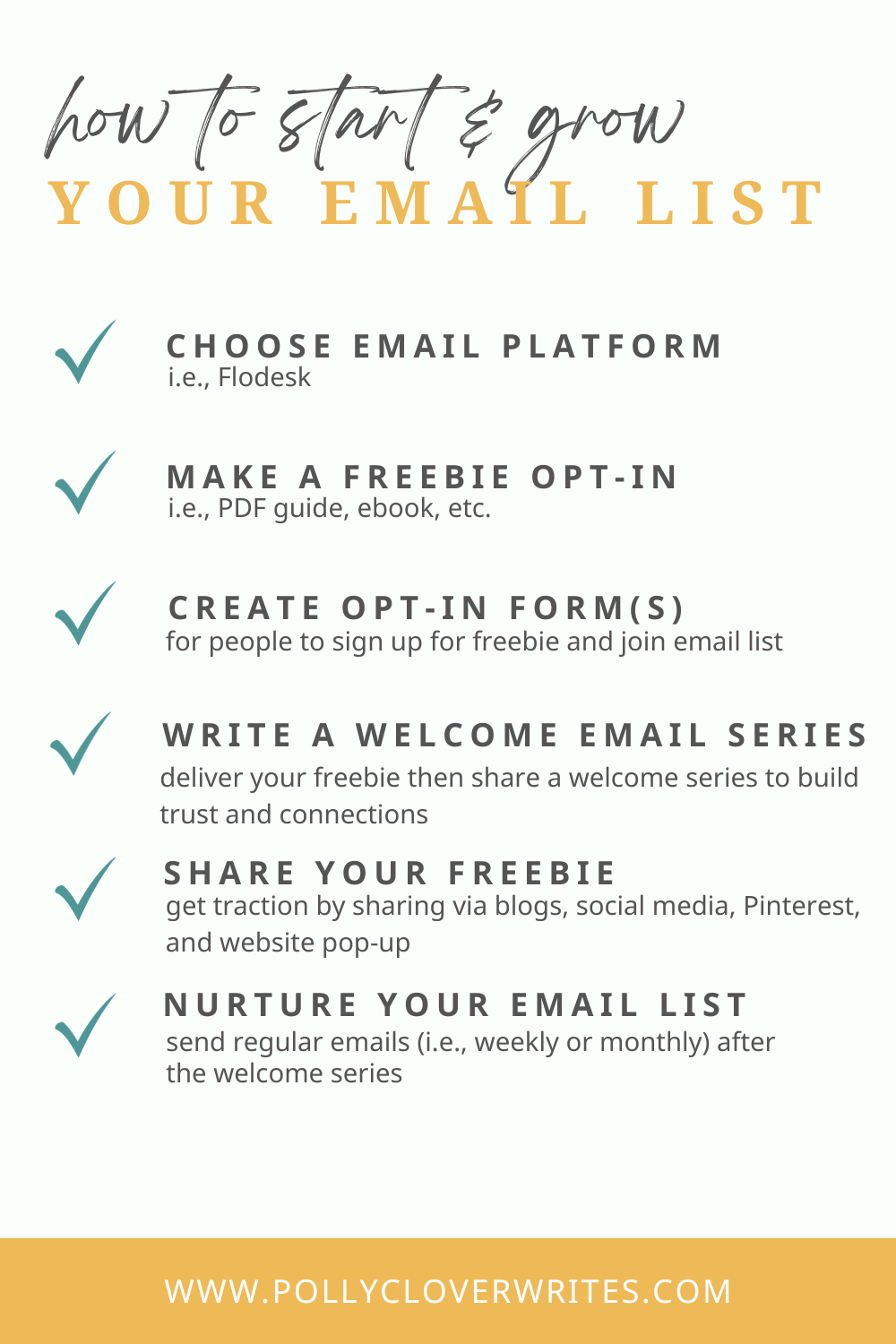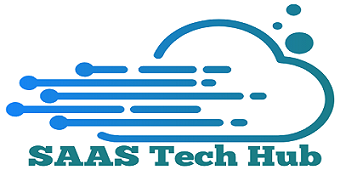Building an email list is crucial for email marketing success. It connects you with potential customers directly.
An email list is a collection of email addresses gathered through various methods. It allows businesses to reach their audience effectively. But why is it important? An email list can drive more engagement, increase sales, and build brand loyalty. In this guide, we will explore the steps to create a valuable email list.
You will learn practical strategies to attract and retain subscribers. Ready to grow your email list? Let’s dive into the basics and set you up for email marketing success.

Credit: www.pollycloverwrites.com
Introduction To Email List Building
Building an email list is a crucial part of email marketing. An email list consists of contacts who have opted to receive your emails. These contacts can be potential customers, existing clients, or anyone interested in your updates. Email list building involves collecting these contacts in an organized way.
Importance Of An Email List
An email list is vital for several reasons. First, it gives you direct access to potential customers. Unlike social media, where algorithms control visibility, your emails reach the inbox. This direct approach increases the chances of engagement.
Second, having a well-maintained email list helps build a strong relationship with your audience. Regular updates keep your brand in their mind. This helps in building trust and loyalty over time.
Finally, an email list is a valuable asset. You own it. Even if a social media platform changes its policies, your email list remains intact. This control makes it a reliable marketing tool.
Benefits Of Email Marketing
Email marketing offers several benefits. One major benefit is its cost-effectiveness. Sending emails is cheaper than other forms of marketing. This makes it a great option for small businesses.
Email marketing also allows for personalization. You can segment your email list based on different criteria. This lets you send targeted messages to specific groups. Personalized emails have higher open and click rates.
| Benefit | Description |
|---|---|
| Cost-effective | Cheaper than traditional marketing methods. |
| Personalization | Send targeted messages based on user preferences. |
| Direct Access | Reach your audience directly in their inbox. |
| Measurable | Track open rates, click rates, and conversions. |
Lastly, email marketing is measurable. Tools like open rates, click rates, and conversion rates help you track the success of your campaigns. This data can help you refine your strategy for better results.
Creating A Compelling Lead Magnet
Creating a compelling lead magnet is key to building an email list. A lead magnet is an incentive offered in exchange for a user’s email address. The right lead magnet can attract and retain subscribers. It provides value and solves a problem for your audience.
Types Of Lead Magnets
Lead magnets come in various forms. Each type can attract different audiences. Here are some common types:
- Ebooks: In-depth guides on a specific topic.
- Checklists: Step-by-step guides that are easy to follow.
- Templates: Pre-made documents or forms that save time.
- Webinars: Live or recorded sessions that teach something valuable.
- Quizzes: Interactive tools that provide personalized results.
Designing An Effective Lead Magnet
Design plays a crucial role in the success of a lead magnet. An effective design attracts attention and builds trust. Here are some tips for designing an effective lead magnet:
- Keep it simple: Avoid clutter. Focus on clear and concise information.
- Make it visually appealing: Use high-quality images and readable fonts.
- Ensure it’s valuable: Offer real solutions to your audience’s problems.
- Highlight benefits: Show how the lead magnet can help the user.
- Use a strong call to action: Encourage users to take the next step.
By focusing on these elements, you can create a lead magnet that attracts and engages your audience. Remember, the goal is to provide value and build trust.
Optimizing Your Signup Forms
Optimizing your signup forms is essential for building a strong email list. Well-designed forms can attract more subscribers. They can also improve your email marketing efforts. Let’s explore how to optimize your signup forms effectively.
Placement Of Signup Forms
Put signup forms in visible spots on your website. The top of your homepage is a great place. Consider the sidebar as well. These locations catch the eye of visitors quickly. A footer form works too. It allows users to sign up as they finish reading.
Using a pop-up form can also be effective. But make sure it is not annoying. Set it to appear after a user spends some time on your site. This ensures they are engaged before you ask them to subscribe.
Best Practices For Signup Forms
Keep your signup forms short. Ask for only necessary information. Usually, a name and email address are enough. Long forms can scare off potential subscribers. A simple form makes it easy for users to sign up quickly.
Use clear and compelling calls to action. Words like “Join Now” or “Subscribe Today” are effective. Make your button stand out with a bright color. Ensure it is easy to find and click.
Provide value to your subscribers. Tell them what they will get. Offer a freebie like an eBook or a discount. This gives them a reason to join your list. Highlight the benefits clearly on your form.
Ensure your forms are mobile-friendly. Many users access websites on their phones. A mobile-optimized form improves user experience. It also increases the chances of sign-ups.
Utilizing Landing Pages
Utilizing Landing Pages is a powerful strategy for building your email list. A landing page is a standalone web page. Its purpose is to capture visitor information through a lead form. This page can turn your visitors into subscribers. Let’s dive into how to create high-converting landing pages.
Elements Of A High-converting Landing Page
To create an effective landing page, certain elements are essential. Here are some key components:
- Compelling Headline: Grab attention with a clear, concise headline.
- Engaging Subheadline: Explain your offer in a few words.
- High-Quality Images: Use visuals that support your message.
- Clear Call to Action (CTA): Direct users to take the desired action.
- Minimal Form Fields: Ask only for necessary information.
- Social Proof: Include testimonials or reviews.
- Concise Copy: Keep the text short and to the point.
These elements help in creating a landing page that converts. Let’s look at some examples.
Examples Of Successful Landing Pages
Examining successful landing pages can provide inspiration. Here are two examples:
| Example | Description |
|---|---|
| Example 1: Dropbox | Dropbox’s landing page is simple. It features a clear headline, a single image, and a straightforward CTA. The form asks only for an email address. |
| Example 2: Airbnb | Airbnb uses a compelling headline and user-friendly form. The page includes high-quality images and social proof, such as reviews. |
These examples show that simplicity and clarity are key. Use these elements to create your own high-converting landing page and grow your email list.
Leveraging Social Media
Leveraging social media can be a powerful strategy to build an email list for email marketing. Social media platforms offer vast audiences and tools that can help you attract and engage potential subscribers. By using social media effectively, you can reach more people and grow your email list faster.
Promoting Your Lead Magnet
One effective way to leverage social media is by promoting your lead magnet. A lead magnet is a valuable resource you offer in exchange for someone’s email address. Share posts about your lead magnet on your social media profiles.
Create eye-catching images and compelling captions. Explain the benefits of the lead magnet. Use a clear call-to-action, like “Download now” or “Get your free guide.” This encourages people to sign up for your email list.
Pin your lead magnet post to the top of your profile. This ensures it gets maximum visibility. Share it in relevant groups and communities. Engage with your audience by responding to comments and questions.
Using Social Media Ads
Social media ads can also help build your email list. Platforms like Facebook, Instagram, and LinkedIn offer targeted advertising options. You can reach specific demographics based on interests, behaviors, and location.
Create ad campaigns that promote your lead magnet. Use attention-grabbing headlines and visuals. Make sure your ad copy highlights the value of your lead magnet. Include a strong call-to-action, like “Sign up now” or “Get instant access.”
Track the performance of your ads. Adjust your targeting and creatives based on what works best. Test different ad formats, like carousel ads or video ads, to see what resonates with your audience.
By leveraging social media and using these strategies, you can effectively grow your email list and enhance your email marketing efforts.
Collaborating With Influencers
Collaborating with influencers can give your email list a significant boost. Influencers have a dedicated audience that trusts their recommendations. By working with the right influencers, you can reach new potential subscribers who are interested in your brand. This strategy is both effective and efficient. Below are some steps to help you get started.
Identifying The Right Influencers
Choosing the right influencers is crucial for the success of your campaign. You need to find influencers who align with your brand values and target audience. Here are some tips:
- Look for influencers in your niche.
- Check their engagement rates.
- Review their content quality.
- Analyze their audience demographics.
Tools like BuzzSumo and Followerwonk can help you find and analyze influencers. Make sure to spend time on this step; it will pay off in the long run.
Crafting Effective Collaboration Campaigns
Once you have identified the right influencers, the next step is to craft an effective collaboration campaign. Here’s how:
- Define Your Goals: Know what you want to achieve. More subscribers? Better engagement? Clear goals will guide your campaign.
- Choose the Right Type of Content: Decide on the content type. Blog posts, social media shoutouts, or giveaways? Each has its benefits.
- Provide Clear Instructions: Make sure the influencer knows what you expect. Provide guidelines but allow some creative freedom.
- Offer Incentives: Give the influencer something valuable. This could be payment, free products, or exclusive offers.
- Track Performance: Use tracking links or promo codes to measure the success of your campaign.
Remember, the key is to build a genuine relationship with influencers. This will make your campaigns more authentic and effective.
Hosting Webinars And Events
Hosting webinars and events is a powerful way to build your email list for email marketing. These live sessions engage your audience and offer valuable content. They also provide a platform to capture new leads. Here’s how you can leverage webinars and events to grow your email list.
Planning A Webinar
Planning is key to a successful webinar. Here’s a simple guide:
- Choose a relevant topic: Pick a topic that interests your audience.
- Set a date and time: Choose a time when your audience is most likely to attend.
- Promote your webinar: Use social media, emails, and your website to spread the word.
- Create a landing page: This page should collect attendee information like name and email.
- Prepare content: Develop engaging and informative content. Include visuals like slides and videos.
Turning Attendees Into Subscribers
After the webinar, your goal is to turn attendees into subscribers. Here’s how:
- Send a follow-up email: Thank attendees for joining and include a call-to-action.
- Offer additional resources: Provide a free eBook, guide, or checklist related to the webinar topic.
- Invite them to join your email list: Clearly state the benefits of subscribing to your list.
- Use a special offer: Offer a discount or special deal for new subscribers.
By hosting webinars and events, you create a platform to engage your audience. This not only builds your email list but also strengthens your relationship with potential customers.

Credit: optinmonster.com
Monitoring And Analyzing Performance
Building an email list is only the first step in email marketing. To make the most out of your efforts, monitoring and analyzing performance is crucial. This helps you understand what works and what doesn’t. It also allows you to fine-tune your strategy for better results.
Key Metrics To Track
Start by focusing on key metrics. These metrics give you a clear picture of your campaign’s success.
Open rate is one key metric. It shows how many people opened your email. A high open rate indicates good subject lines and engaged subscribers.
Click-through rate (CTR) is another important metric. It measures how many people clicked on links within your email. A high CTR suggests your content is compelling and relevant.
Conversion rate tracks the number of people who completed a desired action. This could be making a purchase or signing up for a webinar.
Unsubscribe rate is also essential. A high unsubscribe rate may indicate issues with your content or frequency of emails.
Using Data To Improve Your Strategy
Data collected from these metrics can guide your future campaigns. Identify patterns and trends to understand what your audience prefers.
For example, if your open rate is low, experiment with different subject lines. A/B testing can help you find the most effective ones.
If your CTR is low, review your content. Ensure that it is engaging and offers value to your readers. Consider using more visuals or making your calls-to-action (CTAs) more compelling.
High unsubscribe rates may require you to rethink your email frequency. You might also need to segment your list better to ensure more targeted content.
Remember, continuous monitoring and analyzing performance is key. It helps you stay on top of your email marketing game and achieve better results.
Conclusion And Next Steps
Building an email list is crucial for successful email marketing. This section will summarize key points and provide guidance for planning future campaigns. Let’s ensure you are well-prepared to keep your email list engaged and growing.
Summarizing Key Points
Let’s review the important steps in building an email list:
- Offer valuable content: Create content that your audience finds useful.
- Use sign-up forms: Place forms on your website where they are easy to see.
- Promote your list: Use social media and other channels to encourage sign-ups.
- Segment your list: Group your subscribers based on their interests.
- Keep it clean: Regularly update and clean your email list to remove inactive subscribers.
By following these steps, you will build a strong and engaged email list.
Planning Future Campaigns
Now that you have a solid email list, plan your future campaigns effectively:
- Set clear goals: Define what you want to achieve with each campaign.
- Create a content calendar: Plan your emails in advance to ensure consistency.
- Test and optimize: Experiment with different subject lines, content, and sending times to see what works best.
- Analyze results: Use analytics to understand how your campaigns perform and make improvements.
By planning and analyzing, you will ensure your email marketing campaigns are effective and engaging.

Credit: blog.hubspot.com
Frequently Asked Questions
What Are The Best Ways To Build An Email List?
The best ways include offering incentives, using sign-up forms, hosting webinars, and promoting through social media.
How Can I Grow My Email List Quickly?
To grow quickly, use lead magnets, run contests, collaborate with influencers, and leverage paid advertising.
Why Is An Email List Important For Marketing?
An email list is crucial for direct communication, increasing engagement, and driving sales through targeted campaigns.
How Do I Ensure Quality Subscribers?
Ensure quality by using double opt-ins, segmenting your list, and providing valuable, relevant content consistently.
Conclusion
Building an email list is essential for successful email marketing. Start with clear goals and strategies. Use sign-up forms on your website. Offer valuable incentives like eBooks or discounts. Engage with social media followers to grow your list. Keep your content relevant and engaging.
Consistently monitor and clean your list to improve performance. A well-maintained email list helps you connect better with your audience. This leads to more effective marketing and higher conversion rates. Start today and see the benefits of a strong email list.


